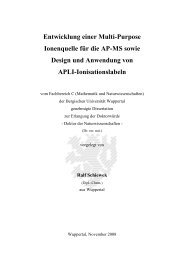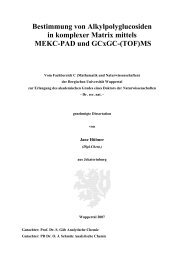The Influence of Oxidative Stress, Carcinogens and Cloning on DNA ...
The Influence of Oxidative Stress, Carcinogens and Cloning on DNA ...
The Influence of Oxidative Stress, Carcinogens and Cloning on DNA ...
You also want an ePaper? Increase the reach of your titles
YUMPU automatically turns print PDFs into web optimized ePapers that Google loves.
5<br />
Introducti<strong>on</strong><br />
regi<strong>on</strong>s can suppress the gene expressi<strong>on</strong> <str<strong>on</strong>g>of</str<strong>on</strong>g> the associated gene (34, 39) . This gene silencing<br />
takes place as the methylati<strong>on</strong> within promoter regi<strong>on</strong>s is associated with transcripti<strong>on</strong>al repressi<strong>on</strong><br />
<str<strong>on</strong>g>of</str<strong>on</strong>g> the gene (40) <str<strong>on</strong>g>and</str<strong>on</strong>g> behaves as a switch <str<strong>on</strong>g>of</str<strong>on</strong>g>f for the affected gene.<br />
1.2.2 Chromatin structure <str<strong>on</strong>g>and</str<strong>on</strong>g> transcripti<strong>on</strong> repressi<strong>on</strong><br />
Both <strong>DNA</strong> methylati<strong>on</strong> <str<strong>on</strong>g>and</str<strong>on</strong>g> hist<strong>on</strong>e modificati<strong>on</strong> are the two major mechanisms that regulate<br />
gene expressi<strong>on</strong>, thus it is very important to underst<str<strong>on</strong>g>and</str<strong>on</strong>g> how the hist<strong>on</strong>e modificati<strong>on</strong> affects<br />
the chromatin structure that dictates the gene expressi<strong>on</strong> pattern emerging from the human<br />
genome.<br />
<str<strong>on</strong>g>The</str<strong>on</strong>g> unmethylated CG dinucleotides in gene promoter regi<strong>on</strong>s are free to act as receptors for<br />
the transcripti<strong>on</strong> factors <str<strong>on</strong>g>and</str<strong>on</strong>g> enable the initiati<strong>on</strong> <str<strong>on</strong>g>of</str<strong>on</strong>g> the transcripti<strong>on</strong> process. However, methylati<strong>on</strong><br />
<str<strong>on</strong>g>of</str<strong>on</strong>g> CpGs is catalyzed by several <strong>DNA</strong> methyltransferases as DNMT1 (<strong>DNA</strong> (cytosine-5-)-methyltransferase-1),<br />
DNMT3a <str<strong>on</strong>g>and</str<strong>on</strong>g> DNMT3b (41) <str<strong>on</strong>g>and</str<strong>on</strong>g> interferes with the binding <str<strong>on</strong>g>of</str<strong>on</strong>g><br />
many transcripti<strong>on</strong> factors (21, 42) . But, methylated CpGs facilitate the assembly <str<strong>on</strong>g>of</str<strong>on</strong>g> transcripti<strong>on</strong><br />
repressor complexes that include hist<strong>on</strong>e deacetylases (HDAC), hist<strong>on</strong>e methyl transferases<br />
<str<strong>on</strong>g>and</str<strong>on</strong>g> chromatin remodeling ATPase (43) . Finally, this represents a c<strong>on</strong>necti<strong>on</strong> between three<br />
mechanisms CpG methylati<strong>on</strong>, chromatin structure modificati<strong>on</strong> <str<strong>on</strong>g>and</str<strong>on</strong>g> gene silencing. Clearly,<br />
<strong>DNA</strong> methylati<strong>on</strong> is involved with silencing <str<strong>on</strong>g>of</str<strong>on</strong>g> the gene, which is suspected to induce a<br />
higher density <str<strong>on</strong>g>of</str<strong>on</strong>g> the chromatin structure. This modificati<strong>on</strong> <str<strong>on</strong>g>of</str<strong>on</strong>g> chromatin limits the accessi-<br />
bility to the promoter sites leading to transcripti<strong>on</strong> repressi<strong>on</strong> (21, 27, 44) .<br />
This complicated mechanism can be clarified in figure 4. <str<strong>on</strong>g>The</str<strong>on</strong>g> methylated CpG sites <str<strong>on</strong>g>of</str<strong>on</strong>g>fer<br />
binding points for m-CpG binding proteins involved in gene repressi<strong>on</strong> such as MBD1,<br />
MBD2 (methyl-CpG binding domain-1 <str<strong>on</strong>g>and</str<strong>on</strong>g> 2) <str<strong>on</strong>g>and</str<strong>on</strong>g> MeCP2 (methyl CpG binding protein 2)<br />
(45)<br />
. <str<strong>on</strong>g>The</str<strong>on</strong>g>se proteins in turn <str<strong>on</strong>g>of</str<strong>on</strong>g>fer binding sites to transcripti<strong>on</strong>al co-repressors, which finally<br />
associate with transcripti<strong>on</strong> repressi<strong>on</strong> mediated factors (hist<strong>on</strong>e deacetylase, hist<strong>on</strong>e methy-<br />
lases <str<strong>on</strong>g>and</str<strong>on</strong>g> chromatin ATPases) (46) . <str<strong>on</strong>g>The</str<strong>on</strong>g> deacetylati<strong>on</strong> <str<strong>on</strong>g>of</str<strong>on</strong>g> hist<strong>on</strong>e (47-49) restricts the access to<br />
promoter regi<strong>on</strong>s due to more densely packed nucleosomes <str<strong>on</strong>g>and</str<strong>on</strong>g> more c<strong>on</strong>densed chromatin<br />
structure, leading to repressi<strong>on</strong> <str<strong>on</strong>g>of</str<strong>on</strong>g> gene activity <str<strong>on</strong>g>and</str<strong>on</strong>g> stop <str<strong>on</strong>g>of</str<strong>on</strong>g> the transcripti<strong>on</strong> (50-52) .




